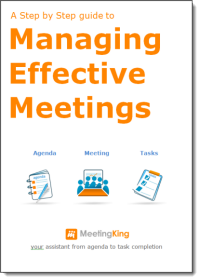We’ve already explained how to write meetings minutes, and shown how to use the Meeting Minutes template. But how do you use those meeting minutes to get things done?
Just to remind you – MeetingKing makes it extremely simple to write down the meeting minutes as the meeting progresses. You can write down notes, decisions and tasks, and make them private (so only you can see what you’ve written), or for the team (so all the meeting participants will be able to see them).
Now, as you all know, meetings are supposed to help you drive your business forwards. Meetings are held to hear different point of views, make decisions, and create and assign tasks. As the meeting progresses, the minutes begin to fill up with decisions, and of course, tasks to back those decisions.
Lets have a look at the task creation dialogue for a second:
When you create a task, you assign an owner, make sure there’s a due date (you CAN leave this blank, but it’s better not to), and add any files that may be required by the task (an Excel list of clients, a JPG of the latest design). Leaving the ‘Email Task’ option checked means that the task is immediately emailed to the task owner, with a link back to the meeting and task.
By clicking ‘Task Summary’ on the left, you can see all the tasks from this meeting, along with who you assigned them to, and their status.
Take this example:
Once the meeting is over, it is the meeting organiser’s job to send out the minutes, along with the decisions and tasks (just one click, with MeetingKing :)). Now everyone can see the decisions made -, ‘The minutes must be sent out right after the meeting’, for example, and the tasks involved ‘Make sure everyone knows about the new policy’. As you can see, the task is assigned to me, and I have to make sure that everyone in the company knows that they need to send meeting minutes at the end of every meeting by the 10th of September. Luckily, I work at MeetingKing – and sending minutes after the meeting is over is second nature to us, so I can cross that task of my list 🙂
So the meeting wasn’t just to ‘decide’ something, and leave it at that. Decisions arrived at in the meeting are broken down into their component tasks, and these tasks are assigned on the spot to meeting participants, along with a deadline, if necessary. Combine this with the follow up meeting feature, and you’ve just turned your meetings into a super-effective powerhouse of getting things done!


